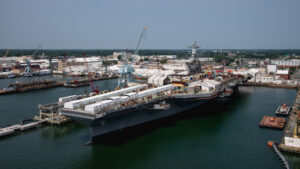The Navy awarded HII [HII] a modification totaling $393 million on June 23 to help change the delivery strategy for the future Ford-class aircraft carrier
John F. Kennedy (CVN-79) to a single-stage delivery process.
The Defense Department contract announcement split the awards into a $274 million fixed-price incentive (firm target) and a $119 million cost-plus-fixed-fee and cost-plus-incentive-fee modifications.

Officially, this covers actions “ to improve capability at ship delivery, define unpriced change orders, and for additional engineering and integrated logistics support for Pre-Commissioning Unit John F. Kennedy (CVN 79)” the announcement said.
In a statement, HII confirmed this will revise the delivery approach for CVN-79 to shift work previously planned for the Post-Shakedown Availability (PSA) into the baseline construction contract. The second Ford-class carrier is currently expected to be delivered by July 31, 2025.
“The contract modification reflects extensive collaboration with the Navy, as we have supported their decision to change the delivery strategy. This strategy will decrease post-delivery work required and increase ship capability and readiness at delivery,” Lucas Hicks, NNS vice president for the John F. Kennedy (CVN-79) new construction aircraft carrier program, said in a statement.
The Navy’s fiscal year 2024 budget request documents, released in March, confirmed the Kennedy will be delivered 13 months later than previously planned due to the shift of work as part of the change from a two phase to single phase delivery (Defense Daily, March 24).
CVN-79 was originally going to be delivered in two phases, with the hull, mechanical and electrical construction finished by the middle of FY ‘22, followed by a nine-month post-delivery shakedown before moving to an 18-month post-shakedown availability/selected restricted availability for Phase II work to incorporate other systems and electronics like the Enterprise Air Surveillance Radar (EASR).
The goal of that two-phase version was to incorporate EASR and procure and install electronics as late as possible to minimize obsolescence management as well as to more quickly deliver the ship to replace the USS Nimitz (CVN-68) by the time it retires in the 2020s.
The switch to single phase delivery was decided in early 2020 to better mitigate schedule risk and reduce post-delivery costs while also expecting the final delivery schedule would still be on time for 2024 (Defense Daily, March 27, 2020).
Then, also in 2020, the Navy awarded HII a $315 million modification to switch from the two-phase to single-phase delivery process while also adding F-35C capabilities (Defense Daily, Nov. 3, 2020).